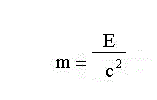E = mc2, equation in German-born physicist Albert Einstein’s theory of special relativity that expresses the fact that mass and energy are the same physical entity and can be changed into each other. In the equation, the increased relativistic mass (m) of a body times the speed of light squared (c2) is equal to the kinetic energy (E) of that body.
In physical theories prior to that of special relativity, mass and energy were viewed as distinct entities. Furthermore, the energy of a body at rest could be assigned an arbitrary value. In special relativity, however, the energy of a body at rest is determined to be mc2. Thus, each body of rest mass m possesses mc2 of “rest energy,” which potentially is available for conversion to other forms of energy. The mass-energy relation, moreover, implies that, if energy is released from the body as a result of such a conversion, then the rest mass of the body will decrease. Such a conversion of rest energy to other forms of energy occurs in ordinary chemical reactions, but much larger conversions occur in nuclear reactions. This is particularly true in the case of nuclear fusion reactions that transform hydrogen to helium, in which 0.7 percent of the original rest energy of the hydrogen is converted to other forms of energy. Stars like the Sun shine from the energy released from the rest energy of hydrogen atoms that are fused to form helium.
Kinetic Energy


What Does this all Mean
Basically the belief is that all matter has energy that makes up it’s entity. The amount of energy held by the entity is in direct proportion to the units Mass.
http://www.emc2-explained.info/Emc2/Derive.htm#.Wd2Bbmj-mUk
If you look at E = mc2 and solve for mass the equation looks like

Since C is constant Energy and Mass are totally dependant on each other, and it is obvious that if you increase energy that the mass will change too.
However this is not the full formula. E = mc2 is the energy potential within a stationery object. Once it starts moving we have to take into account its velocity. The formula as follows is the full formula. You can see that when an object is not moving then the bottom line will equal 1. Thus holding E = mc2 as true.
Full Formula

Energy is calculated by the Mass x Speed of light squared divided by square root of 1 minus the velocity squared divided by speed of light squared.
If mass increases then yes the energy increases, but also true if velocity increases so does the energy increase. So it is possible to increase an objects velocity without increasing its actual mass.
Now when the objects velocity comes closer to the speed of light the bottom part of the line approaches a result of 0, and then the equation falls apart.
If we rearrange the formula to solve for mass (m)

If you increase Energy then Mass will increase, however the strange thing happens is that as you increase velocity the mass actually decreases, if the energy stays the same.
Food for Thought any how?


Leave a comment